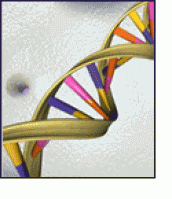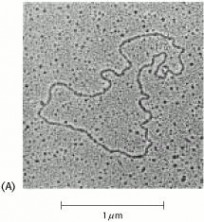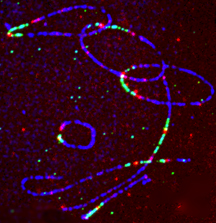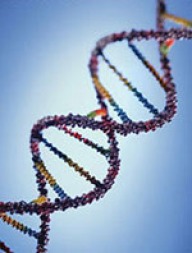DNA, Queries and Insights for Review About Deoxyribonucleic Acid

DNA Molecule Replication NIGMS, NIH
DNA is one of the most interesting and intriguing molecules ever discovered. DNA's 3-D molecular structure was first characterized and reported in Nature in 1953. The DNA molecule continues to fascinate and intrigue scientists and non-scientists alike. National DNA Day in 2010, 2011 and years beyond will continue to reveal new information. Here are 20 questions or queries that give insights, and remind all of the basic facts and fundamental DNA information that will never change. Be challenged and be informed about DNA, deoxyribonucleic acid.
DNA, Queries 1 to 5 for Review About Deoxyribonucleic Acid

Segment of a DNA Molecule
1. If a typical bacterial DNA is isolated properly the DNA is noted to be of what form or shape?
A. circular B. linear C. neither of the previous.
2. If a typical plant DNA is isolated properly, the DNA is noted to be of what form or shape?
A. circular B. linear C. neither of the previous.
3. If typical human DNA is isolated properly, the DNA is noted to be of what form or shape?
A. circular B. linear C. neither of the previous.
4. A typical prokaryote, such as Escherichia coli, has how many complete DNA molecules?
A. 1 B. 3 C. 4
5. A chromosome if isolated and studied would
A. contain or have DNA B. would not have DNA
A. circular B. linear C. neither of the previous.
2. If a typical plant DNA is isolated properly, the DNA is noted to be of what form or shape?
A. circular B. linear C. neither of the previous.
3. If typical human DNA is isolated properly, the DNA is noted to be of what form or shape?
A. circular B. linear C. neither of the previous.
4. A typical prokaryote, such as Escherichia coli, has how many complete DNA molecules?
A. 1 B. 3 C. 4
5. A chromosome if isolated and studied would
A. contain or have DNA B. would not have DNA
DNA, Queries and Insights for Review About Deoxyribonucleic Acid, 6 to 10

Mitochondrial DNA
6. Which of the following is the correct pairing in DNA?
A. purine to purine B. pyrimidine to pyrimidine C. purine to pyrimidine
7. Which one of the following is not part of any DNA pairing?
A. arginine B. adenine C. cytosine D. guanine E. thymine
8. Which TWO terms best define DNA molecules?
A. alpha helix B. double helix C. triple helix D. protein E. nucleotides
9. One of the listed scientists is not credited with the discovery of the DNA molecular structure.
Who is that one person?
A. James Watson B. Francis Crick C. Maurice Wilkins D. Rosalind Franklin E. Linus Pauling
10. One scientist contributed to the discovery of DNA's structure, but did not receive a Nobel Prize. Who was that scientist?
A. James Watson B. Francis Crick C. Maurice Wilkins D. Rosalind Franklin E. Linus Pauling
A. purine to purine B. pyrimidine to pyrimidine C. purine to pyrimidine
7. Which one of the following is not part of any DNA pairing?
A. arginine B. adenine C. cytosine D. guanine E. thymine
8. Which TWO terms best define DNA molecules?
A. alpha helix B. double helix C. triple helix D. protein E. nucleotides
9. One of the listed scientists is not credited with the discovery of the DNA molecular structure.
Who is that one person?
A. James Watson B. Francis Crick C. Maurice Wilkins D. Rosalind Franklin E. Linus Pauling
10. One scientist contributed to the discovery of DNA's structure, but did not receive a Nobel Prize. Who was that scientist?
A. James Watson B. Francis Crick C. Maurice Wilkins D. Rosalind Franklin E. Linus Pauling
DNA, Queries and Insights for Review About Deoxyribonucleic Acid, 11 to 15

Plasmid DNA Molecules
11. Which type bond is involved between any two paired nitrogen bases of DNA?
A. ionic B. hydrogen C, covalent
12. Which type bond links the sugar to the phosphate in DNA?
A. ionic B. hydrogen C, covalent
13. Indicate which 2 features of the sugar apply to DNA molecules?
A. ribose B. hexose C. glucose D. extra oxygen E. missing one oxygen
14. DNA would be what kind of molecule when analyzed chemically?
A. acid B. base
15. The bondings between paired nitrogen bases (as asked in question 11) are
A. exactly the same, regardless of pariing B. dependent on type pairing
A. ionic B. hydrogen C, covalent
12. Which type bond links the sugar to the phosphate in DNA?
A. ionic B. hydrogen C, covalent
13. Indicate which 2 features of the sugar apply to DNA molecules?
A. ribose B. hexose C. glucose D. extra oxygen E. missing one oxygen
14. DNA would be what kind of molecule when analyzed chemically?
A. acid B. base
15. The bondings between paired nitrogen bases (as asked in question 11) are
A. exactly the same, regardless of pariing B. dependent on type pairing
DNA, Queries and Insights for Review About Deoxyribonucleic Acid, 16 to 20

DNA, Molecule of Life
16. DNA replicates in what manner?
A. dispersive B. conservative C. semiconservative
17. A scientist compares the DNA replication of bacteria, plants and animals and notes the replications are?
A. similar in each B. distinctly different for each C. sometimes different, sometimes similar
18. Genes can be defined as a distinct and discrete number of
A. phosphates B. sugars C. nucleotides
19. Genes usually are shut down or promoted to work as a direct result of what type molecular interaction with the gene?
A. RNA B. DNA C. protein
20. If a gene mutates it:
A. dies B. becomes larger C. becomes smaller D. changes E. cannot work any more
All the Written Material within Site is Copyrighted 2010 and Owned by Dr. Donald Reinhardt, and this original material is protected legally by this copyright notice and by the Digital Millennium Act. None of this original material may be copied or reproduced without the expressed written consent of the author.
The author is a Freelance Science writer, and is available for specific assignments for those who are interested – by contacting adminstrator@sciencesuperchool.com. Other questions related to this teaching site should be directed to teacher@sciencesuperschool.com.
A. dispersive B. conservative C. semiconservative
17. A scientist compares the DNA replication of bacteria, plants and animals and notes the replications are?
A. similar in each B. distinctly different for each C. sometimes different, sometimes similar
18. Genes can be defined as a distinct and discrete number of
A. phosphates B. sugars C. nucleotides
19. Genes usually are shut down or promoted to work as a direct result of what type molecular interaction with the gene?
A. RNA B. DNA C. protein
20. If a gene mutates it:
A. dies B. becomes larger C. becomes smaller D. changes E. cannot work any more
All the Written Material within Site is Copyrighted 2010 and Owned by Dr. Donald Reinhardt, and this original material is protected legally by this copyright notice and by the Digital Millennium Act. None of this original material may be copied or reproduced without the expressed written consent of the author.
The author is a Freelance Science writer, and is available for specific assignments for those who are interested – by contacting adminstrator@sciencesuperchool.com. Other questions related to this teaching site should be directed to teacher@sciencesuperschool.com.
Click Here for 20 DNA Answers for National DNA Day, or Any Day